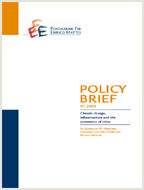Reducing Emissions from Deforestation and forest Degradation (REDD): wich role for REDD in future climate regimes?
Deforestation and forest degradation are responsible for approximately 17% of global greenhouse gas (GHG) emissions. The Kyoto Protocol currently excludes avoided deforestation in developing countries as an option to stabilize Greenhouse Gas (GHG) emissions, but a decision on the inclusion of Reducing Emissions from Deforestation and forest Degradation (REDD) is expected to be a key part of the overall negotiation for a future climate policy framework at the 15th COP, Copenhagen, 2009. Allowing REDD credits to be used for compliance in cap-and-trade programs not only has the potential to reduce the costs of compliance, but it could also create a strong incentive for the protection of tropical forests that would transform the dynamics for forest protection world-wide and encourage large emissions reductions in the forested developing world. Various concerns however still exist, including the concern that REDD would serve to ‘offset’ rather than supplement actions in industrialized countries and critical economic sectors, and that the risk of low-cost mitigation opportunities through REDD could ‘flood’ the market, reducing incentives for technological innovation. However recent research suggests that various options exist for containing this risk within a well-designed carbon market, which could provide significant immediate benefits in terms of climate change mitigation and forests preservation, globally.

